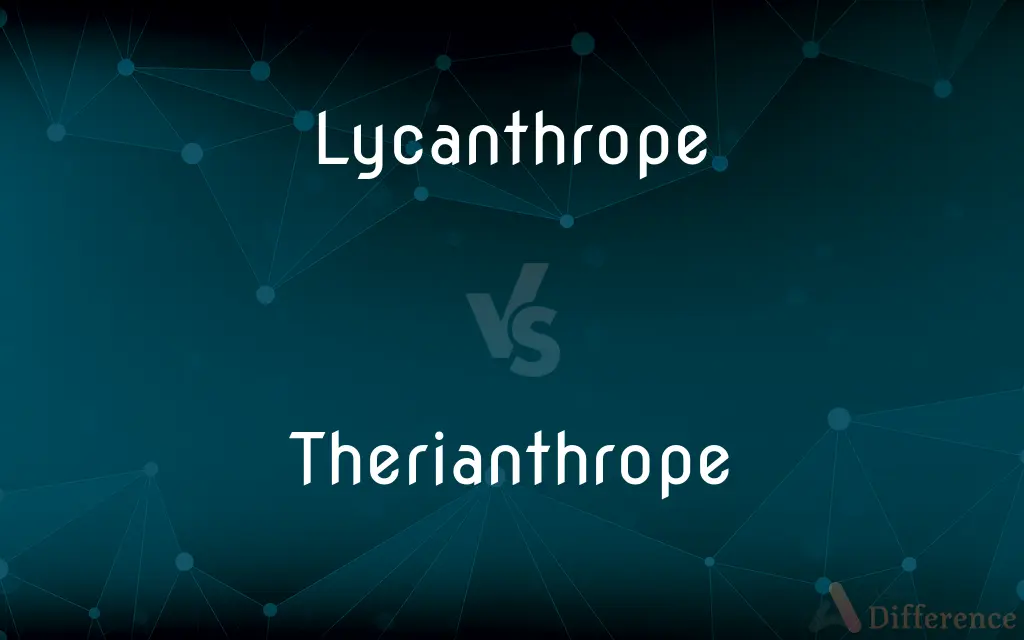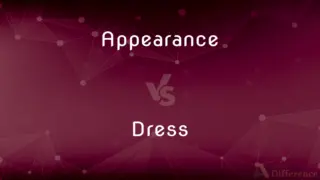Lycanthrope vs. Therianthrope — What's the Difference?
Edited by Tayyaba Rehman — By Maham Liaqat — Updated on April 21, 2024
Lycanthrope specifically refers to a werewolf, often in folklore as a human who transforms into a wolf, while a therianthrope describes a broader category of mythological beings that can transform into any animal.

Difference Between Lycanthrope and Therianthrope
Table of Contents
ADVERTISEMENT
Key Differences
Lycanthropes are traditionally depicted in mythology and folklore as humans who can transform into wolves, often under the influence of a full moon. In contrast, therianthropes represent a wider range of mythological creatures that can transform into various animals, not limited to wolves. This distinction highlights the specific versus the general in mythical transformations.
The concept of a lycanthrope is closely tied to European folklore, particularly stories involving werewolves that emerge as malevolent creatures during a full moon. On the other hand, therianthropes appear in various cultural mythologies worldwide, including the Egyptian god Anubis, who is depicted with a jackal's head, and the Native American skinwalkers who can change into any animal they desire.
Lycanthropy is often associated with the affliction or curse that causes the transformation, specifically focusing on the uncontrollable and fearful aspects of turning into a wolf. Whereas, therianthropy can be seen as a more neutral or even revered ability depending on the culture, where transformation can involve any animal and might be viewed as a spiritual or protective presence.
In popular culture, lycanthropes are predominantly portrayed in horror genres, emphasizing the curse and the horror of their transformation. Meanwhile, therianthropes can be featured in a variety of genres, often taking roles that explore themes of identity, metamorphosis, and the connection between humans and nature, depending on the animal they become.
Lycanthropes in literature and film are usually central to narratives that explore themes of duality, struggle with identity, and often the horror of losing one’s humanity. Therianthropes, however, can symbolize a broader range of themes including power, adaptability, and the breaking of boundaries between human and animal worlds.
ADVERTISEMENT
Comparison Chart
Definition
A human who transforms into a wolf.
A human who can transform into any animal.
Origin of Folklore
Primarily European.
Worldwide, across various cultures.
Symbolism
Curse, horror, and dual nature.
Transformation, spirituality, and adaptability.
Cultural Representation
Often negative, viewed as a curse or affliction.
Can be either revered or feared, depending on the culture.
Common in
Horror films and Gothic literature.
Diverse genres, including fantasy and spiritual narratives.
Compare with Definitions
Lycanthrope
A human with the ability to transform into a wolf.
In folklore, a lycanthrope changes form at the full moon.
Therianthrope
Often symbolizes flexibility and spiritual transcendence.
The therianthrope in the novel represents adaptability and wisdom.
Lycanthrope
Usually linked to European folklore.
Lycanthropes feature prominently in medieval European tales.
Therianthrope
A mythical figure who can transform into any animal.
Therianthropes in these stories embody spiritual guides.
Lycanthrope
Often portrayed as a cursed individual in mythology.
The cursed lycanthrope dreaded the coming of the full moon.
Therianthrope
Appears in diverse global mythologies.
Therianthropes are central in many Native American myths.
Lycanthrope
Central to many horror stories and films.
The lycanthrope became the terrifying antagonist in the movie.
Therianthrope
Can be portrayed positively or negatively, depending on the context.
In some cultures, a therianthrope is a revered protector.
Lycanthrope
Associated with themes of loss of control and humanity.
The novel explores the lycanthrope's battle with his vanishing humanity.
Therianthrope
Not restricted to any specific animal form.
The therianthrope could become any animal, from birds to big cats.
Lycanthrope
A werewolf.
Therianthrope
(mythology) Any mythical being which is part human, part animal.
Lycanthrope
A person affected with lycanthropy.
Therianthrope
Someone with an intense spiritual or psychological identification as a non-human animal.
Therianthropes don't feel a need to dress in fursuits, because they believe they already are their animal, inside.
Lycanthrope
A werewolf
Lycanthrope
More generally, any sort of were-creature.
Lycanthrope
A human being fabled to have been changed into a wolf; a werewolf.
Lycanthrope
One affected with lycanthropy.
Lycanthrope
A monster able to change appearance from human to wolf
Common Curiosities
Are lycanthropes always evil in stories?
Not always, but lycanthropes are often portrayed with a menacing or tragic nature due to their uncontrollable transformation and violent tendencies.
Can therianthropes control their transformations?
In many stories, therianthropes have the ability to control their transformations, unlike lycanthropes whose changes are often involuntary.
What kind of genres do lycanthropes appear in?
Lycanthropes are commonly found in horror and gothic genres where their transformations are used to evoke fear and suspense.
Are therianthropes based on real animals?
Yes, therianthropes in mythology are often based on real animals but may possess supernatural qualities and abilities.
What are some famous lycanthrope characters in literature?
Characters like Lawrence Talbot in "The Wolf Man" and Remus Lupin in "Harry Potter" are notable examples of lycanthropes in literature.
Is there a specific cultural significance to lycanthropes?
In European cultures, lycanthropes often symbolize the internal struggle between man's civilized nature and untamed wildness.
How are therianthropes used symbolically in literature?
Therianthropes can symbolize transformation, adaptability, and sometimes the bridging of the natural and supernatural worlds.
What causes someone to become a lycanthrope in folklore?
Typically, becoming a lycanthrope involves a curse or a bite from another lycanthrope, according to various folk tales.
How do therianthropes reflect the values of the cultures they appear in?
In many cultures, therianthropes are seen as protectors or beings with a deep connection to the spiritual world, reflecting a culture's relationship with nature and the animal kingdom.
Do therianthropes appear in modern media?
Yes, therianthropes appear in various forms in modern media, including films, television series, and books, often bringing a fantasy or magical element to the narrative.
What powers do therianthropes typically have in myths?
Besides transforming, therianthropes often have enhanced senses, strength, or other abilities associated with their animal forms.
How do cultural perceptions of lycanthropes differ globally?
While often feared in European narratives, lycanthropes can be viewed more sympathetically or as tragic figures in other cultures, illustrating different attitudes towards curses and afflictions.
What role do lycanthropes play in mythology?
Lycanthropes often serve as cautionary tales about the perils of succumbing to one's baser instincts and losing one's humanity.
Can therianthropes be found in folklore around the world?
Yes, many cultures around the world have myths of therianthropes, ranging from the weretigers of Asia to the jaguar men of South America.
Are there specific rituals associated with lycanthropes in folklore?
Some folklore includes specific rituals either to become a lycanthrope or to cure one, often involving magic or herbal remedies.
Share Your Discovery

Previous Comparison
Linear vs. Tactile
Next Comparison
Appearance vs. DressAuthor Spotlight
Written by
Maham LiaqatEdited by
Tayyaba RehmanTayyaba Rehman is a distinguished writer, currently serving as a primary contributor to askdifference.com. As a researcher in semantics and etymology, Tayyaba's passion for the complexity of languages and their distinctions has found a perfect home on the platform. Tayyaba delves into the intricacies of language, distinguishing between commonly confused words and phrases, thereby providing clarity for readers worldwide.














































